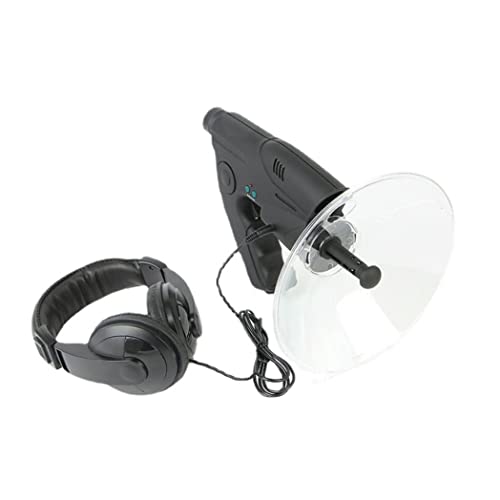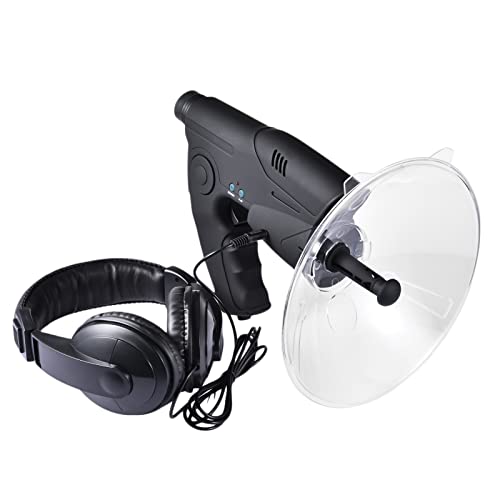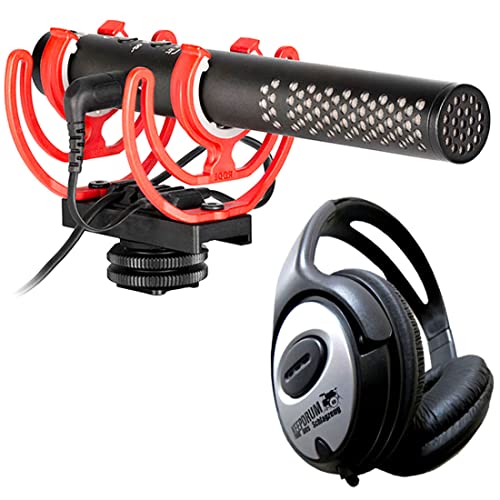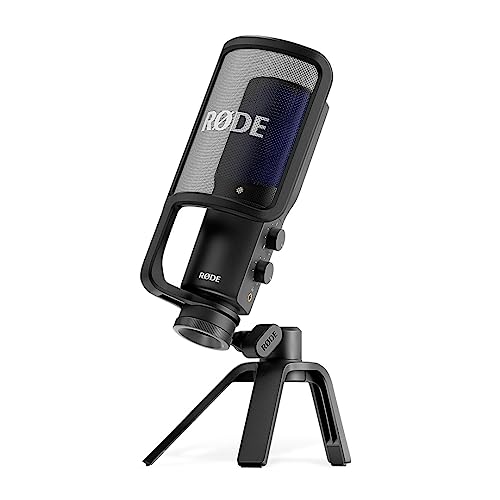What is a directional microphone?
A directional microphone is a directional microphone that has a shielding effect and is aimed at a target when recording. Directional microphones are particularly popular in film and television. They are used to record interviews or the conversation between two actors on set.
The directional microphone is used as a parabolic microphone in so-called field recording, for example. Sound designers specifically record the birdsong of a specific species. The directional microphone can be recognized by its extended tube, which is usually covered with a windscreen or protected by a windscreen basket.
In the parabolic directional microphone test, it is also used by private detectives. They use the directional microphone as a listening device to record conversations for evidence.
In contrast to the handheld microphone, the directional microphone in the test is mounted on the camera or on a portable articulated arm, also known as a boom pole. The advantage is that you don't see the directional microphone on the video recording.
How does a directional microphone work?
The directional microphone consists of three different components and is easily recognizable as such by its long tube shape. The end of the tube is usually used as a handle. Connection cable, such as a XLR-Cables can be connected here.
Occasionally there is a battery compartment in the extended handle that is used to power the microphone. The microphone capsule is located in the middle of the tube.
The polar pattern of most directional microphones is either lobe or hypercardioid. This ensures that the sound entering the front is recorded in a targeted manner. The shotgun is located at the front end of the shotgun microphone.
This is open to the front. The sound coming in from the front is thus let in and reaches the microphone capsule directly.
There are numerous gap-like openings on the side of the shotgun, which also let in sound. The openings can be found on the right and left side of the directional microphone.
This design leads to the cancellation principle of the frequencies. The sound enters on both sides at the same time and there is a frequency superimposition. The sound is thus extinguished. This is to prevent noises that are next to the directional microphone from being recorded.
Advantages & areas of application of a directional microphone
Film & TV
The directional microphone is used in both film and television. The sound assistant holds a boom pole on which the directional microphone is in a holder. The directional microphone should not interfere when a film is being shot.
It must not protrude into the picture and should only record the dialogue of the actors. The boom pole is therefore held at an angle over the camera.
The boom boom is angled so that it can be aimed exactly at the actors. Background noises, such as road traffic, are then only faintly audible later in the recording. When interviewing television, the directional microphone is either hand-held or attached directly to the camera.
The great advantage of the directional microphone is that it superimposes lateral noise due to the phase shift and thus eliminates it. The directional characteristic often corresponds to a lobe, which means that only the Ton is recorded, which acts on the microphone from exactly in front.
Directional microphone as a listening device
The directional microphone with its range is popular with the military as well as with detectives as a spy tool. The directional microphone can eavesdrop on conversations through a window. The directional microphone range is up to 100 meters. Professional devices can even exceed this distance.
There are various ways of jamming a directional microphone. So-called audio jammers are used for highly sensitive conversations, for example in industry or in the military. These noise generators are placed in the direction of the suspected directional microphone.
They then generate an ultrasonicSignalDisturbing nearby bugs. Jamming the directional microphone is not that easy, but can be achieved with a noise generator. Positioning the directional microphone on the window does not help in this case.
Especially if the noise generator is placed at the window. The directional microphone can then only perceive the noise at the window. Before you use a directional microphone for espionage, you should check the legal situation carefully, otherwise you could be liable to prosecution.
Directional microphone for sound design
The parabolic directional microphone is used by sound designers, naturalists and bird watchers to record sounds in nature.
Biologists can observe rare species more specifically and study their behavior better using the recorded sounds. Bird watchers are able to use the parabolic microphone to record the song of a specific bird species.
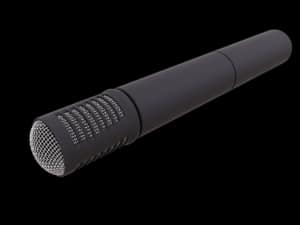
For sound designers, the parabolic directional microphone is indispensable in the test. For example, they record the sound of a waterfall, the movement of clothes or just footsteps.
The sound recordings are then used either for the film or for a computer game. Due to its size, a directional microphone on the mobile phone is also practical for the sound designers who need a Klang want to record.
It can be easily stowed away and is basically ready for use at any time. An app can be helpful when recording bird calls.
This can narrow down the species if you are not immediately sure. If the directional microphone is on the mobile phone, simply point it in the direction of the bird. The app then helps determine the species of bird.
What should I look out for when buying a directional microphone?
If you want to buy a directional microphone, you should first think about which recording device you want to use. The intended use also plays a major role. You can't take good nature shots with a directional microphone for your cell phone.
In such a case, a parabolic microphone is required. This can be aimed at an audio source and, thanks to the increased focal point, ensures a crystal-clear recording.
In the test, the parabolic directional microphone is particularly popular with ornithologists who want to record the birdsong of a specific species. When testing a directional microphone, the directional characteristic indicates how sensitive the microphone is in the respective main direction.
Does it isolate the sound backwards, is the directional characteristic rather broad or is it only allowed in one specific direction? Before you want to buy a directional microphone, you should look at the different directional characteristics on the polar diagram.
The ball is very common in parabolic directional microphones, as this clearly outlines the entire parabolic mirror. In order to reduce ambient noise, however, the kidney can also be recommended.
The frequency range resolves how sensitive the directional microphones are in certain frequency ranges. Lower frequencies in particular are weaker in order to reduce nearby noises such as footsteps.
The mirror size in a parabolic microphone plays a role frequency response a role in that larger mirrors depict the low-frequency range better.
Powering the directional microphone
Before you want to buy a directional microphone, it is important to take a look at how the directional microphone is fed. Some microphones can be powered by a battery. Others require phantom power supplied by an external device.
Before buying, you can listen to sound samples on the Internet. These can be found either on the manufacturer's website or on video portals and in sound technology forums. In these forums you can ask questions and also receive purchase advice from experienced users.
The inherent noise is an important feature in the directional microphone test. Because you want to have the clearest possible recordings that are not distorted by noise. Self-noise measures how noisy the microphone is when there is no external sound.
For this purpose, it is left in a soundproof container by the manufacturers in the directional microphone test. The inherent noise is displayed in dB-A.
This weighting is closest to the sensitivity of the human ear. Before buying, you should find out about the manufacturer support. Because a directional microphone is a listening device that is exposed to the weather when used outdoors.
It can be damaged there, which is why good customer support and a long guarantee are features that should influence a purchase decision.
Directional Microphone FAQ
How do you attach a directional microphone in the test?
The directional microphone is either on the hot shoe Adapter mounted on the camera, on the smartphone with an audio connector and in a windscreen in the appropriate holder. The Boom Pole has its own grab handle.
Where can you buy a directional microphone?
Directional microphones can be bought from any online retailer, as well as in individual specialty stores. Online trading offers numerous advantages over specialist shops. These include stress-free shopping, door-to-door delivery and easier comparison options.
Is a directional microphone a listening device?
Some parabolic directional microphones are marketed as listening devices. The directional microphone has a range of up to 100 meters. The parabolic directional microphone is specifically used in tests by nature lovers and bird watchers to record birdsong. Some private detectives use the directional microphone for espionage.
How does the directional microphone work?
The sound that comes through the side openings is superimposed. Frequencies are thus erased. As a directional microphone, the microphone capsule has a club-like characteristic. Only the sound that enters the tube of the directional microphone head-on is recorded.
What is the range of a directional microphone?
This depends heavily on the parabolic microphone used. Some directional microphones have a range of up to 100 meters. Depending on the audio software used, the volume can be increased in post-processing, which means that longer ranges are possible.
What types of directional microphones are there?
Parabolic directional microphone
The parabolic microphone can be easily recognized by the large parabolic mirror that surrounds the directional microphone. This is available in different versions. Either as a permanently installed product solution or individually as a parabolic mirror in which a directional microphone can be integrated.
The parabolic mirror achieves a much higher directivity in the middle and high frequencies. With a normal stereo microphone you can only make random recordings.
Although it is still possible to isolate individual sounds in post-processing in the studio, the recording can lose its character as a result.
The parabolic mirror, in the focal point of which the microphone is installed, can be aimed directly at the respective target. The parabolic directional microphone is primarily used in tests by sound designers, biologists and ornithologists.
Directional microphone on cell phone
The directional microphone on the cell phone is a more compact solution than the parabolic microphone. It is simply attached to the edge of the smartphone with an audio connector. Vloggers, Youtubers and Live broadcaster targeted. These benefit from the improved audio quality of a shotgun mic.
A special moment can be captured at any time without the construction taking much time. These devices are extremely easy to use. The directional microphone is simply plugged into the mobile phone.
If the windscreen is already on the directional microphone, a recording can be started within a few seconds.
This makes setup much faster and easier than with a larger directional microphone. Monitoring is still possible during the recording via the integrated headphone socket. Many manufacturers include a wind protection cover with the delivery.
Directional microphone for espionage
In the last category there are built-in directional microphones that were specifically designed for espionage purposes. The directional microphone for spying has a parabolic microphone that is already aligned from the moment of purchase.
No adjustment or attachment of the microphone is necessary. The directional microphone has a range of up to 100 meters. It can eavesdrop on conversations through windows as a directional microphone, as long as you stand close to the source.
Many devices have a small recording memory on which the conversations can be stored digitally. But they can also be connected to an external field recorder. These devices are used in particular by detective agencies and private detectives for observation.
So-called audio jammers are used to jam a directional microphone. These noise generators create a subliminal noise that ruins any recording.
Jamming a directional microphone is particularly important with highly sensitive information. In industry, for example, to avoid disclosing certain product details before a product is published.
This is how directional microphones were tested
The microphones are first sorted by price and category by the testers in the specialist magazines. A test field is defined in advance so that the magnitude of the test can be kept in mind. The directional microphone is then tested in various situations.
For example, how well it can pick up speech or vocals in the studio. How the recordings sound outdoors with and without a windscreen. Several recordings are made in one go, in which the microphone is held in the hand, mounted on a boom pole or on the camera's hot shoe.
In the test, an interview situation is simulated. The test person takes turns standing at different distances from the microphone and repeats the same sentence over and over again.
The test shows the range of the directional microphone and how good the recordings sound at different distances. It is also checked to what extent the directional microphone shields sounds coming from the side.
After all, this is one of the main tasks of a directional microphone. For better comparability, the recordings of the microphones are not packed into one file as sound samples, but can be played back individually as audio clips.
Data sheets are checked in the laboratory
Specialist magazines go one step further in their test. In order to check the accuracy of the data sheets that the manufacturers specify for their directional microphones, they are sent to a special laboratory.
This attention to detail is intended to deliver exact measurement results that must be repeatable at any time. Based on the measurements in the laboratory, a comparison can be made with the polar diagrams given by the manufacturers.
Both voice recordings and recordings with a musical instrument, such as a guitar, are also recorded here. Several testers then listen to the sound recordings with studio headphones and then draw a conclusion for their test.
The evaluation includes how well the directional microphone performs in a specific situation. For example, whether the video mic attached to the hot shoe adapter is actually suitable for creating interviews. One of the criteria is whether the microphone is well shielded from external influences.
It starts with the handling. A padded grip, for example, can prevent the noise of holding the microphone from being transferred to the recording. Since directional microphones are very sensitive to wind noise, it is checked how well the supplied windscreen dampens it.
In tests by Stiftung Warentest, a material test is also carried out. This not only checks the durability of the materials used, but also whether they can cause harmful side effects, such as plasticizers.
Information on leading manufacturers of directional microphones
Sennheiser
The German company Sennheiser is one of the world's leading companies in the audio technology sector. Today's group was founded as Sennheiser electronic GmbH & Co. KG by the engineer Fritz Sennheiser.
The Sennheiser company grew rapidly during the years of the economic boom. As early as 1955, there were more than 250 employees at the Wennebostel site.
The manufacture of magnetostatic headphones and audio mixers began early. In 1956, the company's first directional microphone came onto the market. The next milestone in Sennheiser's product history followed in 1968. The world's first open-back headphones were made.
Today, Sennheiser has several production facilities in the USA, Germany and Ireland. Over 2600 employees work at these locations.
Rode
Rode is one of the best-known brands in the field of shotgun microphones. The beginnings of the Australian company can be traced back to the Englishman Henry Freedman. Freedman worked as a chief engineer for a telecommunications company.
In addition, he earned extra income as a local representative for the German audio company Dynacord. This offered him the Australian sales rights for the brand. Freedman didn't hesitate and moved to Australia with his family.
He set up a workshop in a suburb of Sydney. Freedman Electronics established itself as a local audio engineering business. When Freedman died in the late 80s, his son Peter inherited a company whose financial situation was difficult. Eager to find a solution, Peter Freedman modified imported microphones from China.
The Rodent-1 was born. This was soon followed by the first directional microphones, which are still successfully on the market today under the name NTG. Today Rode is one of the leading companies in the field of microphone technology.
Neumann
The German brand Neumann has an excellent reputation among audio engineers. The company was founded in Berlin in 1928 by the inventor Georg Neumann. The still young company quickly received the order to produce a new type of microphone for the Olympic Games. After several attempts and tests, the CMV3 condenser microphone finally came onto the market.
Neumann directional microphones can be found in every repertoire of professional sound engineers and studios. A directional microphone like the KMR 81 has an extremely high directivity and hardly any inherent noise.
On average, Neumann microphones are significantly more expensive than the competition's directional microphones. However, they are characterized by high-quality materials and excellent values.
walimex
Walimex was founded in 1998 by Niclas Walser as Foto Walser Spezialversand. The company grew rapidly in the following years with sales on Ebay. In 2003, the Walimex brand was created, which sells numerous items, especially in the field of photo accessories.
In 2011, Walimex took over the well-known tripod manufacturer Mantona and has been the exclusive distributor of Samyang products since 2018. With the Walimex pro shotgun directional microphone Cineast II DSLR, the company sells an inexpensive directional microphone for common system cameras.
audio Technica
Audio Technica is based in the Japanese city of Machida. Hideo Matsushita founded the audio technology company in 1962. The company made a great contribution to the miniaturization of microphones. Audio Technica's directional microphone is known as ATR.
In the tests of the trade magazines, the robust construction and the compact size of the shotgun microphones from the company were positively highlighted. A special feature is the Tele mode, which is intended to better shield certain external noises.
It is a low-cut filter that can filter out mechanical vibrations and engine noise.
Product lines of the manufacturers of directional microphones at a glance
Rode
NTG series
VideoMic Pro+
The directional microphones from the well-known Australian brand are managed as a product line under the name NTG. The smallest version of the series is the Rode VideoMic Pro+, which is designed as a directional microphone for photo and video cameras.
With the handy shotgun mic, Rode promises that the same design principles have been adhered to that also apply to its bigger brother, the NTG5.
The existing USBConnection, which allows the VideoMic Pro+ to be connected to the laptop or home PC. Similar to the NTG5, the VideoMic Pro+ has small round holes on the sides of the shot tube instead of slots.
These should ensure that the sound arriving from the side is superimposed and thus extinguished. The 3,5mm connector has a sensor that automatically detects whether the VideoMic is connected to the PC or to the camera.
NTG1 to NTG5
The condenser shotgun microphones NTG1 to NTG5 are specially designed for professional recordings in film and television. They are characterized by a barely perceptible inherent noise and have a stable metal housing. First-class workmanship ensures a long service life even in poor outdoor conditions.
In addition, there is a multi-year guarantee for Rode products and an accommodating repair service is offered. Low- and high-pass filters that can be set directly on the microphone further simplify handling.
Rode also has a boom pole and a specially made windscreen for the directional microphones. The microphones have a supercardioid characteristic. Because of their excellent properties, Rode microphones can be found on almost every film set.
Sennheiser
MKH series
Sennheiser's high-frequency directional microphones are managed as a product line under the MKH designation. They were specially manufactured for the conditions in outdoor use. You will not only find them in films, but also in nature documentaries. A feature is the very low inherent noise, solid workmanship and easy handling thanks to the attached filter switch.
The microphones of the MKH series are available in different price ranges and with different directional characteristics. Thanks to the large selection in the MKH series, a microphone can be selected for a very specific application.
For example, the MKH-70, MKH-60, and MKH-8070 directional microphones share a lobe-type polar pattern, while the MKH-8050 and MKH-50 share a supercardioid polar pattern.
Where is the best place to buy a shotgun microphone?
Online trade: Shop conveniently and securely
In the parabolic directional microphone test, e-commerce stands out due to several advantages. The large comparison possibilities of the Internet make it possible to make a targeted comparison of the parabolic microphone. Information can be found for each manufacturer.
Prices can be compared at a glance in a comparison table. Important characteristics such as frequency response, feed or directional characteristics can also be easily compared with one another.
Anyone who wants to buy the directional microphone as a listening device can do so in complete anonymity. Buying a directional microphone is possible with just a few clicks online.
There is no queuing at the checkout
Long queues at the checkout are completely eliminated with the Internet. It is not necessary to drive to the respective specialist shop. You don't have to look for a parking space or fight with other drivers for the last parking space. Online trading is completed within a few minutes.
Once paid at the checkout, you only need to wait a few working days for the package to be delivered directly to your front door. In advance, you can find out about the advantages and disadvantages of the respective directional microphones at your leisure during the purchase.
What is the range of the respective directional microphone? Is the directional microphone suitable for the mobile phone? Does the directional microphone work through a window?
All these questions can be answered quickly with a search engine. In audio technology forums you can even get complete purchase advice from experienced users.
Larger selection than in specialist shops
In specialist shops, the selection is usually very limited. There is no longer a large selection of numerous different brands and models. When buying, you rely heavily on the opinion and expertise of the seller.
If you want to use a directional microphone for espionage, you don't necessarily want to make a big deal out of it. Not only can you order anonymously online, but you can also have the parabolic directional microphone in the test packaged as a gift.
The unique service also applies to returns. Many online retailers are accommodating when it comes to a Monday product.
Benefits
- Shipping faster
- opportunity to compare
- Easier handling
- anonymity
- Much information
Disadvantages
- return a little more difficult
Specialized trade
Unlike on the Internet, you can often test a device on site in specialist shops. The specialist trade has to contend with a number of disadvantages compared to the Internet. On the one hand, there is no possibility to obtain comprehensive information about a product. The research must therefore begin before the purchase.
But you don't always remember all the information in the store. It can also happen that the desired product is not in stock. In this case, the trip to the specialist shop was free of charge.
If you want to use a directional microphone for espionage, it is better to keep it under lock and key. However, there is no anonymity in the specialist shop.
The employees in the store don't show you how to jam a directional microphone either. If the desired item is in stock, at least the purchase is completed immediately. A waiting time like on the internet is not necessary in this case. Instead, the item will be wrapped and can be taken home immediately.
Little information
The biggest disadvantage of the specialist shop is that you can hardly find out about the products in stock. There is no clear comparison table, so that you only have to compare the characteristics directly from device to device.
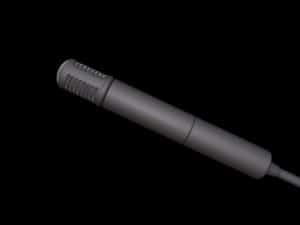
It is easy to forget a characteristic value. There is also no possibility to listen to sound samples. You can find plenty of sound examples of the respective directional microphones on the Internet.
These can be found either in audio technology forums or on the video platform Youtube. Some YouTubers even show whether the directional microphone can record through a window or not. The question of how to effectively jam a directional microphone is also addressed there.
The parabolic microphone is shown in use in various situations. For example how it works in strong winds and how to align it correctly when taking a picture. There you will also find recommendations for equipment.
Benefits
- Direct purchase
- return easier
Disadvantages
- No sound samples
- Hardly any information
- No comparison possible
- smaller selection
- No anonymity
Cleaning of directional microphone and accessories
Extreme care should be taken when cleaning a directional microphone. The manufacturer's information should be observed at all times, otherwise the sensitive microphone capsule could be damaged.
Of course, the directional microphone should be unplugged before cleaning. The supplied windscreen can be cleaned of simple dirt residues with a comb.
The comb should be passed evenly through the deadcat's fur. The front of the windscreen in particular should be cleaned of any residue, since the sound enters from the front with a directional microphone with a supercardioid characteristic.
Many manufacturers include a corresponding comb with the windbreak. The synthetic fur can knot over time, which is why you can untie these knots with the comb.
Cleaning may only be carried out with gentle agents. Of course, you should never put a wet windscreen on the directional microphone. If the windbreak fur gets wet, you should not put it in a dryer, but let it dry naturally indoors.
Then you have to comb the fur again before you can use it for the next mission. As far as detergent is concerned, you should follow the instructions in the instructions for use, as not every deadcat is suitable for a wash cycle.
It is generally recommended for outdoor use that you always have a transport bag at hand. You can then stow the windscreen basket, deadcat and tripod in this if you want to change the recording location. This increases the longevity of the accessories and prevents the equipment from getting dirty.
Directional Microphone Accessory
Field recorder
Sound designers often have to record sounds outside of a recording studio. The background noise, such as the chirping of crickets on a warm summer night or the rumbling of a thunderstorm, is later used as a sound effect for films or video games. A useful device for recording these sounds is what is known as a field recorder.
The recorder is specially designed for the purpose. The portable digital recorders have their own stereo microphones, sufficient storage space and are easy to transport thanks to their compact design.
A parabolic directional microphone can be connected to the field recorder via an XLR connector. Some field recorders, such as the Zoom H6 have their own directional microphone, which can be attached to the field recorder using an adapter.
parabolic mirror
Of course, a parabolic microphone needs a parabolic mirror. In some parabolas, the microphone is already built in. Other solutions have a bracket in which the parabolic directional microphone can be mounted in the focal point. Basically, the size of the parabolic directional microphone ensures a better frequency response in the lower sound ranges.
One point to consider before purchasing is that shielding against wind noise. Parabolic mirrors increase sensitivity, which means that you cannot do without a Dead Cat windscreen.
Boom Pole
The boom pole is an extended rod that is commercially available in various lengths. The directional microphones are attached to its tip. You can use a boom pole to hold the directional microphone through a window when the speakers are underneath. The boom pole is a useful tool.
A directional microphone can interfere if it is held directly in the camera image. When it comes to film in particular, it is important to ensure that you get crystal-clear recordings when two actors are engaged in a dialogue. When filming, the boom pole is held over the camera position by a sound assistant.
It must not appear in the picture, nor should it distract the actors or appear as a shadow on the shot. In addition to film, it is also used in documentaries and occasionally at sporting events.
Carry bag
A carrying bag is very useful for safe storage and easy transport. Not only can the directional microphone be stowed in it, but with the parabolic microphone there is still enough space for the mirror and the recording device.
The highly sensitive devices are protected from dust and bad weather conditions. If you want to buy a directional microphone, you should definitely order a carrying case as well. Especially if outdoor shots are planned.
windscreen basket
The windscreen basket is a special design that shields the parabolic microphone from the wind. The parabolic microphone is mounted inside the windscreen. The parabolic mirror is located at the outer end of the windscreen basket. The basket is almost completely enclosed.
Only the side openings on the basket ensure that the functionality of the parabolic directional microphone is not disturbed. The frequencies overlap. The phase shift cancels out the sound coming in from the side.
microphone cable
With a directional microphone for the mobile phone, a microphone cable is irreplaceable. It connects the audio input of the smartphone with the directional microphone. A cable can be damaged, especially if it is used for a long time. The wear is noticeable through a broken cable.
A replacement cable can save a recording in such a situation. The directional microphone for the mobile phone noticeably improves the audio quality and can be attached to the smartphone.
Flash shoe adapter
With an adapter you can put the parabolic microphone on the hot shoe of the camera. The advantage is that you don't have to hold the directional microphone in your hand during the test if you want to conduct an interview. It is also not visible in the picture and does not interfere with the recording.






























